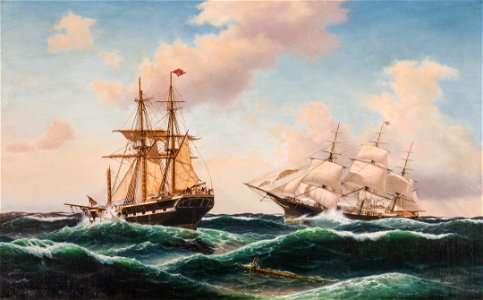Rescue of the royal albert, by john eric christian petersen
depicts the rescue of the royal albert
a dramatic, although historically obscure vision of a maritime drama. It depicts the british blackwall frigate royal albert, dismasted and foundering, her ensign inverted in the universal signal of distress. Her quarter deck is crowded with crew and passengers awaiting rescue by a fast approaching american clipper. The clipper’s crew is scrambling to take off sail and launch their lifeboats in response to royal albert’s signal. The 670 ton barque royal albert was built in london for m. I. Wilson at wigram’s blackwall shipyard by brothers henry and money wigram. She was launched in 1844 and one of the vessels that became popularly known as “blackwall frigates”, her hull was of fir and in 1856 her bottom was sheathed in felt and plates of yellow metal (60% copper and 40% zinc). Barque rigged, she also carried square topsail yards and spencer sails on both her main and mizzen masts. Under captain william robinson, she entered the merchant trade carrying passengers and cargo between london and calcutta. In 1855, under charter to the highland and island emigration society, she began carrying immigrant passengers between plymouth and adelaide, south australia. After 1864, royal albert disappears from all registries, and her fate is unknown. Extensive research has failed to uncover an account of her sinking, or any incident in which she was in distress and assisted by a clipper ship. In this exceptional rendering, royal albert and home port of london are clearly identified on her stern. The american clipper also carries her name on both bow and stern boards, but the name is indecipherable. Date: 1868.
Loading...
